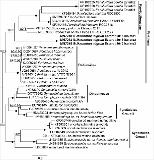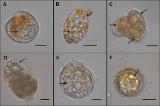Por favor, use este identificador para citar o enlazar a este item:
http://hdl.handle.net/10261/247315COMPARTIR / EXPORTAR:
 SHARE SHARE
 CORE
BASE CORE
BASE
|
|
| Visualizar otros formatos: MARC | Dublin Core | RDF | ORE | MODS | METS | DIDL | DATACITE | |

| Título: | New Perkinsea Parasitoids of Dinoflagellates Distantly Related to Parviluciferaceae Members |
Autor: | Reñé, Albert CSIC ORCID ; Alacid, Elisabet CSIC ORCID; Gallisai, Rachele CSIC ORCID ; Chambouvet, Aurélie; Fernández Valero, Alan D. CSIC ORCID ; Garcés, Esther CSIC ORCID CVN | Palabras clave: | Parasitoids Protist HAB Parvilucifera Phylogeny Evolution |
Fecha de publicación: | ago-2021 | Editor: | Frontiers Media | Citación: | Frontiers in Microbiology 12: 701196 (2021) | Resumen: | Perkinsea is a phylogenetic group of protists that includes parasites of distantly related hosts. However, its diversity is still mainly composed of environmental sequences, mostly obtained from freshwater environments. Efforts to isolate and culture parasitoids of dinoflagellates have led to the description of several phylogenetically closely related species constituting the Parviluciferaceae family. In this study, two new parasitoid species infecting dinoflagellates during recurrent coastal blooms are reported. Using the ribosomal RNA (rRNA) gene phylogenies, we show that both cluster within Perkinsea, one of them at the base of Parviluciferaceae and the other in a distinct branch unrelated to other described species. The establishment of host-parasite lab cultures of the latter allowed its morphological characterization, resulting in the formal description of Maranthos nigrum gen. nov., sp. nov. The life-cycle development of the two parasitoids is generally the same as that of other members of the Parviluciferaceae family but they differ in the features of the trophont and sporont stages, including the arrangement of zoospores during the mature sporangium stage and the lack of specialized structures that release the zoospores into the environment. Laboratory cross-infection experiments showed that the parasitoid host range is restricted to dinoflagellates, although it extends across several different genera. The maximum prevalence reached in the tested host populations was lower than in other Parviluciferaceae members. The findings from this study suggest that Perkinsea representatives infecting dinoflagellates are more widespread than previously thought | Descripción: | 16 pages, 9 figures, 1 table, supplementary material https://www.frontiersin.org/articles/10.3389/fmicb.2021.701196/full#supplementary-material.-- Data Availability Statement: The datasets presented in this study can be found in online repositories. The names of the repository/repositories and accession number(s) can be found in the article/Supplementary Material | Versión del editor: | https://doi.org/10.3389/fmicb.2021.701196 | URI: | http://hdl.handle.net/10261/247315 | DOI: | 10.3389/fmicb.2021.701196 | E-ISSN: | 1664-302X |
| Aparece en las colecciones: | (ICM) Artículos |
Ficheros en este ítem:
| Fichero | Descripción | Tamaño | Formato | |
|---|---|---|---|---|
| Reñe_et_al_2021.pdf | 7,56 MB | Adobe PDF |  Visualizar/Abrir | |
| Reñe_et_al_2021_suppl_table.DOCX | 665,85 kB | Microsoft Word XML | Visualizar/Abrir | |
| Reñe_et_al_2021_suppl_image_1.tif | 1,74 MB | TIFF |  Visualizar/Abrir | |
| Reñe_et_al_2021_suppl_image_2.TIF | 1,34 MB | TIFF |  Visualizar/Abrir | |
| Reñe_et_al_2021_suppl_image_3.TIF | 919,93 kB | TIFF |  Visualizar/Abrir |
CORE Recommender
SCOPUSTM
Citations
9
checked on 25-abr-2024
WEB OF SCIENCETM
Citations
8
checked on 23-feb-2024
Page view(s)
67
checked on 05-may-2024
Download(s)
82
checked on 05-may-2024
Google ScholarTM
Check
Altmetric
Altmetric
Este item está licenciado bajo una Licencia Creative Commons

